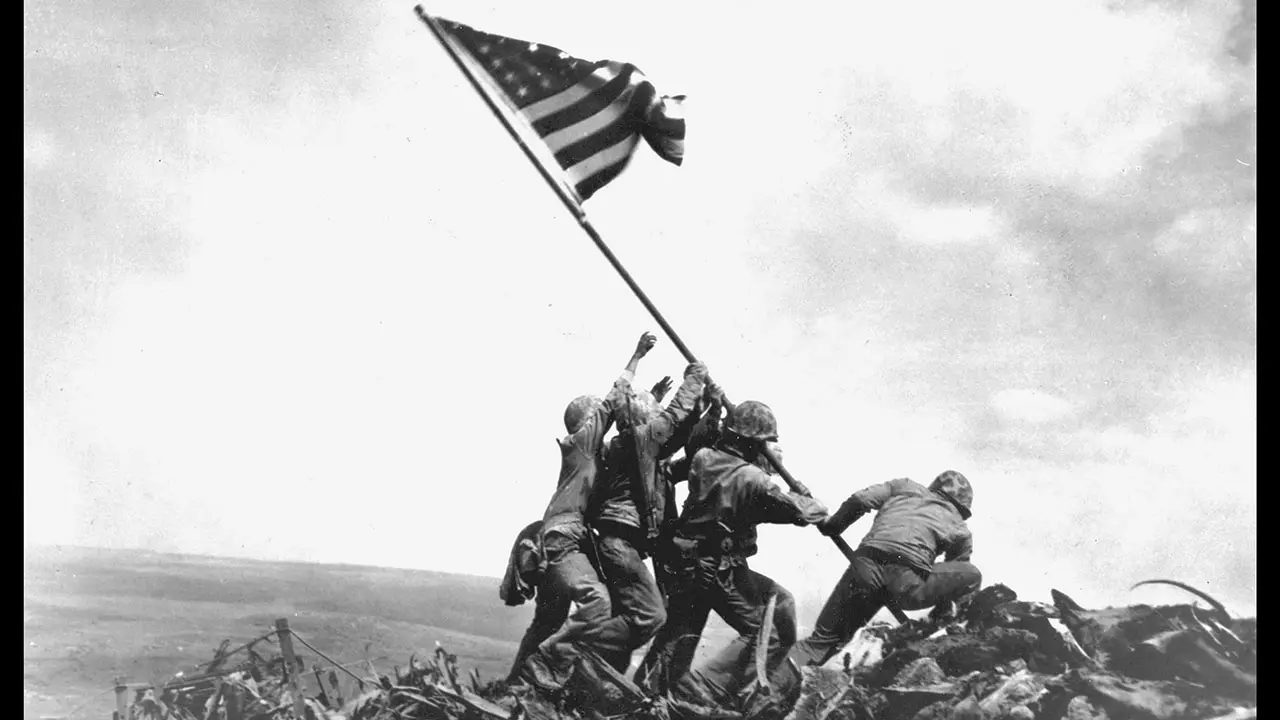Six United States Marines raised the American flag atop Mount Suribachi amid horrific combat on Iwo Jima, the intense war scene captured in perfect angle and framing by photographer Joseph Rosenthal, on this day in history , on February 23, 1945.
The sheer power of the image instantly gripped a nation at war with Nazi Germany in Europe and Imperial Japan in the Pacific: young American fighters displaying the Stars and Stripes on a remote island, far from home, in World War II. .
Its power endures today.
ON THIS DAY IN HISTORY, FEBRUARY 22, 1980, THE US OLYMPIC MEN'S HOCKEY TEAM SHOCKS THE SOVIETS IN 'MIRACLE ON ICE'
“The raising of the flag became a symbol of the American victory in World War II and what the nation can achieve when we all come together for a just cause,” Owen Connor, senior curator at the National Museum of Art, told Fox. the Marine Corps. News Digital last year around this time.
The photograph appeared on the front page of almost every newspaper in the United States within days.
View of members of the Fifth Division of the United States Marine Corps as they raise an American flag on Mount Suribachi during the Battle of Iwo Jima, February 23, 1945. (Joe Rosenthal/Photo 12/Universal Images Group via Getty Images)
It has been duplicated and admired over the decades and endures as the most powerful image of heroism in American history.
The Marines in the photo represent a broad cross-section of the American people.
“Photography became in many ways one of the first media events of the 20th century.” — Owen Connor, National Museum of the Marine Corps
The latest research indicates that men are, from left to right: PFC. Ira Hayes, 22, a book-loving Pima Native from Sacaton, Arizona; PFC. Harold Schultz, 20, of Detroit, who lied about his age to join the Corps after Pearl Harbor; Sergeant. Michael Strank, 25, born in what is now Slovakia and raised in Franklin Borough, Pennsylvania; PFC. Franklin Sousley, 19, a factory worker from Hill Top, Kentucky; Harold Keller, 23, a telephone lineman from Brooklyn, Iowa; and corporal. Harlon Block, 20, a star high school football player from Weslaco, Texas.
MEET THE AMERICAN WHO FIRST COMMANDED THE MARINES: REVOLUTIONARY WAR HERO SAMUEL NICHOLAS
Block, Sousley and Strank died on Iwo Jima, a volcanic island about 700 miles south of Tokyo.
The Marines invaded Iwo Jima on February 19 and its capture was considered essential to tightening the noose around Japanese territory.

Japan/United States: US Marines storm a beach on Iwo Jima, with Mount Suribachi in the background, February 1945. (Story/Universal Images Group via Getty Images)
“It took four days for the Marines to reach the Suribachi summit,” the Department of Defense reports.
“The capture of the 554-foot hill was significant as it extinguished the fires of the entrenched Japanese who had a commanding advantage over much of the island.”
Fighting continued until March 26.
Iwo Jima is considered by many historians to be the largest battle in the history of the Marine Corps.
About 27,000 Marines and sailors were killed or wounded in one month of combat.
Nearly all of the 21,000 Japanese defenders, fighting from caves, tunnels, and entrenched forts, were killed; only 216 were taken prisoner.
Twenty-seven Marines and Navy medics earned the Medal of Honor on Iwo Jima, more than any other battle in U.S. history, according to the National World War II Museum.
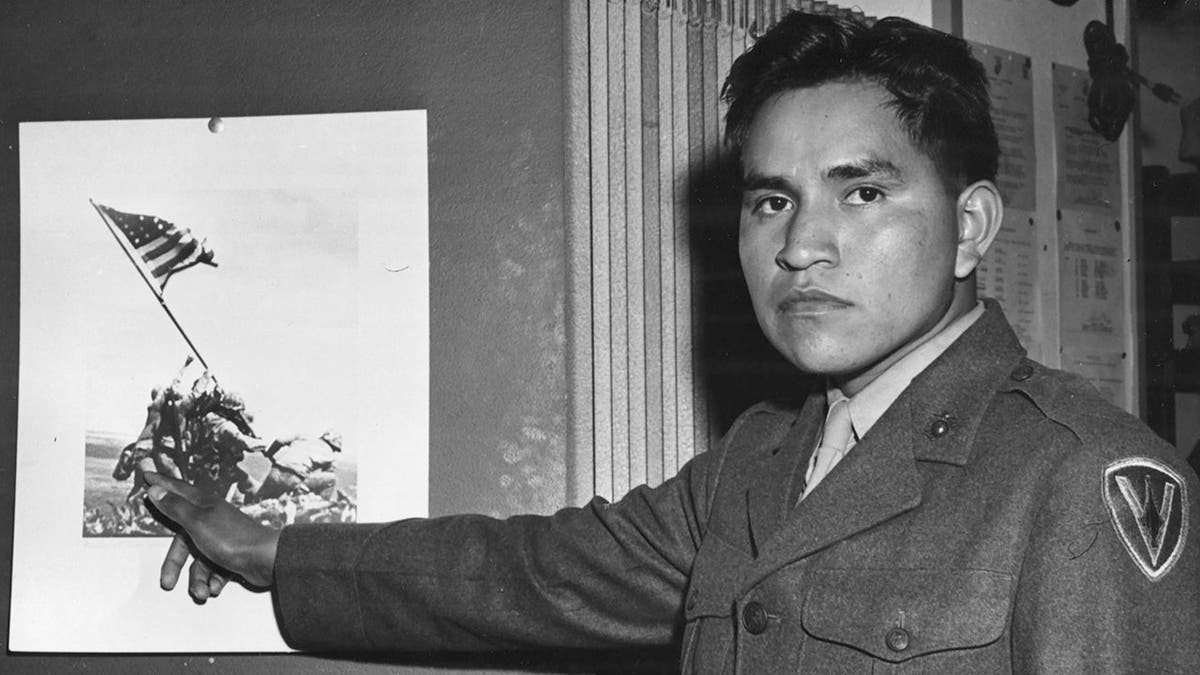
Private First Class Ira Hayes is featured prominently in the historic image of the flag raising on Mount Suribachi, Iwo Jima, 1945. (PhotoQuest/Getty Images)
“Uncommon courage was a common virtue,” Admiral Chester W. Nimitz, who commanded the Navy's war effort in the Pacific, said of Iwo Jima.
“Uncommon courage was a common virtue.” —Admiral Chester W. Nimitz
“The photo became in many ways one of the first media events of the 20th century,” Connor said.
“Because of the speed with which the image went from the battlefield to America's Sunday newspapers (48 hours), it took on even greater meaning for a nation.”
The federal government immediately harnessed the power of photography to aid the war effort.
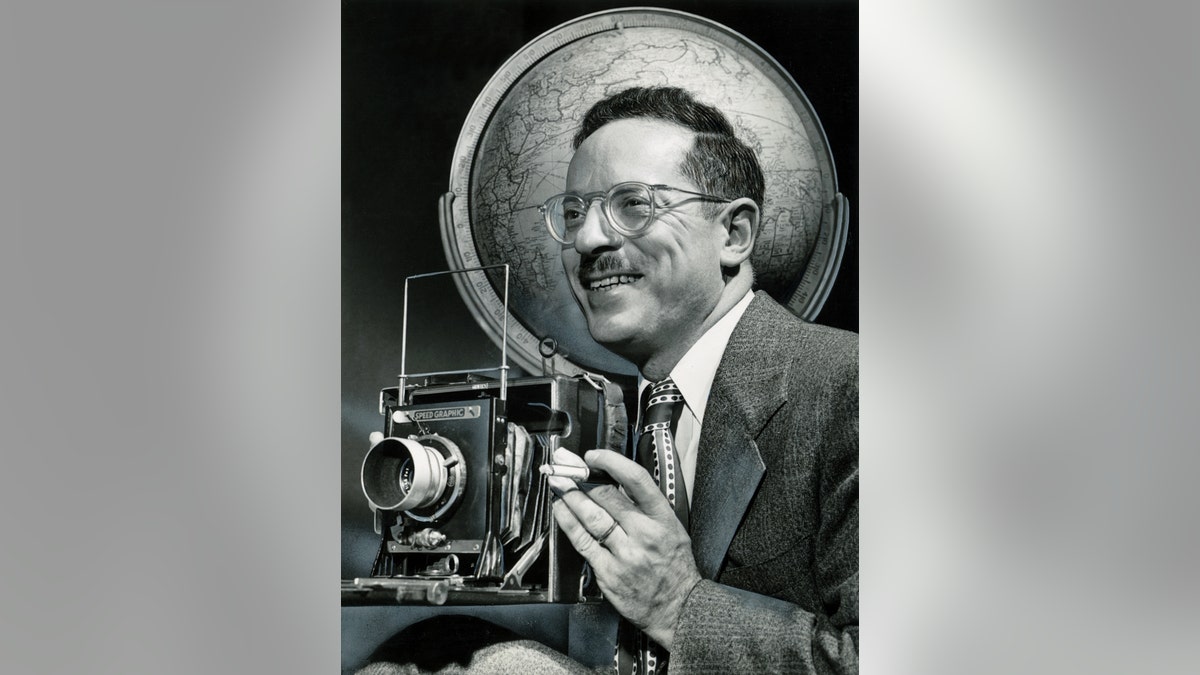
Photographer Joe Rosenthal in 1947. He captured the image of Marines raising the American flag on Iwo Jima on February 23, 1945. (Bob Campbell/San Francisco Chronicle via Getty Images)
“The photograph was the centerpiece of a war bond poster that helped raise $26 billion in 1945,” the Pulitzer Prize Board writes in its online account of the image.
“On July 11, before the war ended, it appeared on a United States postage stamp. Nine years later it became the model for the Marine Corps War Memorial in Arlington, Virginia.”
MEET THE AMERICAN WHO FIGHTED AND DIED AT THE POPLAR BUT LIVED TO TELL HIS HEROIC STORY: SLAVE JOE
The Pulitzer Board typically awards its journalism prizes for the previous year.
He made an exception for Rosenthal's photograph, which received the Pulitzer Prize in April just two months after it was taken.
“The raising of the flag on Iwo Jima became a symbol of… the nation's highest ideals, of embodied courage.” – Author James Bradley
The Battle of Iwo Jima has been immortalized in numerous books, films and even popular music.
“The Ballad of Ira Hayes” tells the sad story of the Pima standard bearer. It was recorded by many artists, including Bob Dylan, and became a hit for Johnny Cash in 1961.
The image's meaning to millions of Americans even today is deeper and more powerful than the well-deserved praise among journalists and artists.
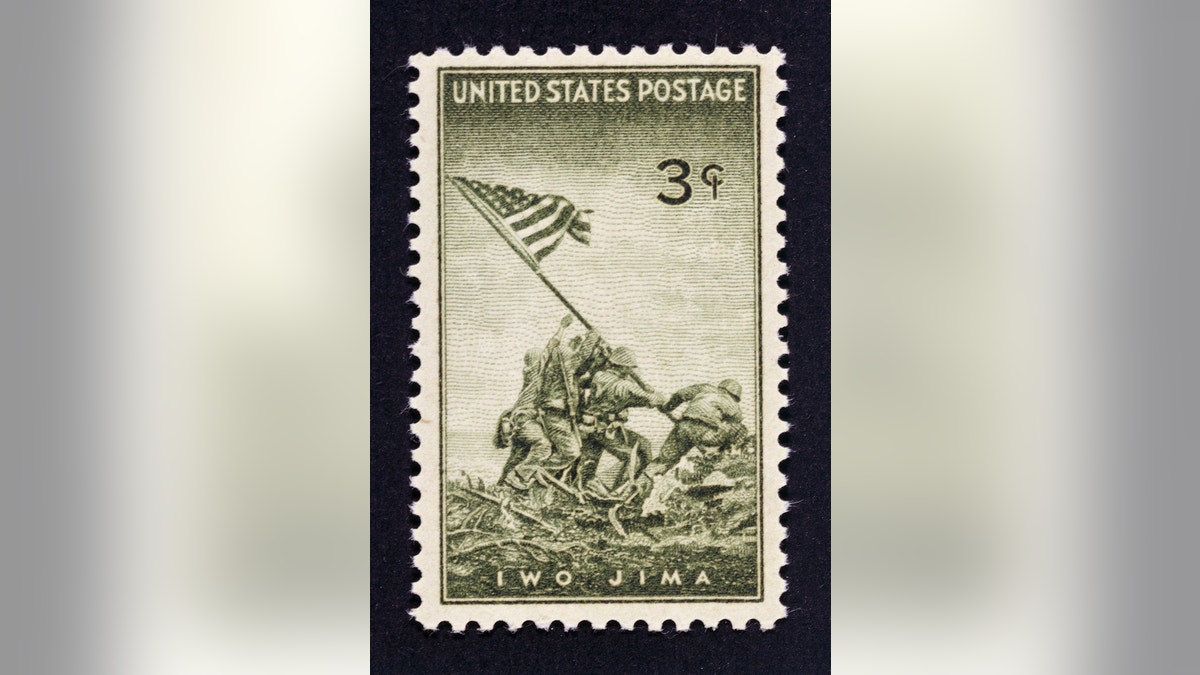
Postage stamp honoring the conquest of the island of Iwo Jima, 1945, depicting Marines raising the United States flag (photo reproduction by Joe Rosenthal). United States of America, 20th century. (DeAgostini/Getty Images)
The rise of Old Glory far from home amid the savagery of global war represents the terrible human struggle to end the tyranny and slavery that ruled the world in the 1940s, for which the American people and their allies fought. to end World War II at once. terrible human cost.
CLICK HERE TO SUBSCRIBE TO OUR LIFESTYLE NEWSLETTER
The identity of the men in the photo has been a source of considerable controversy in recent years. The confusion was caused by numerous factors.
Navy Corpsman John Bradley was one of the men long identified as a flag raiser.
His son James Bradley wrote the powerful 2000 Iwo Jima story, “Flags of Our Fathers,” an intense look at the horror of Iwo Jima and the lives of the men pictured.
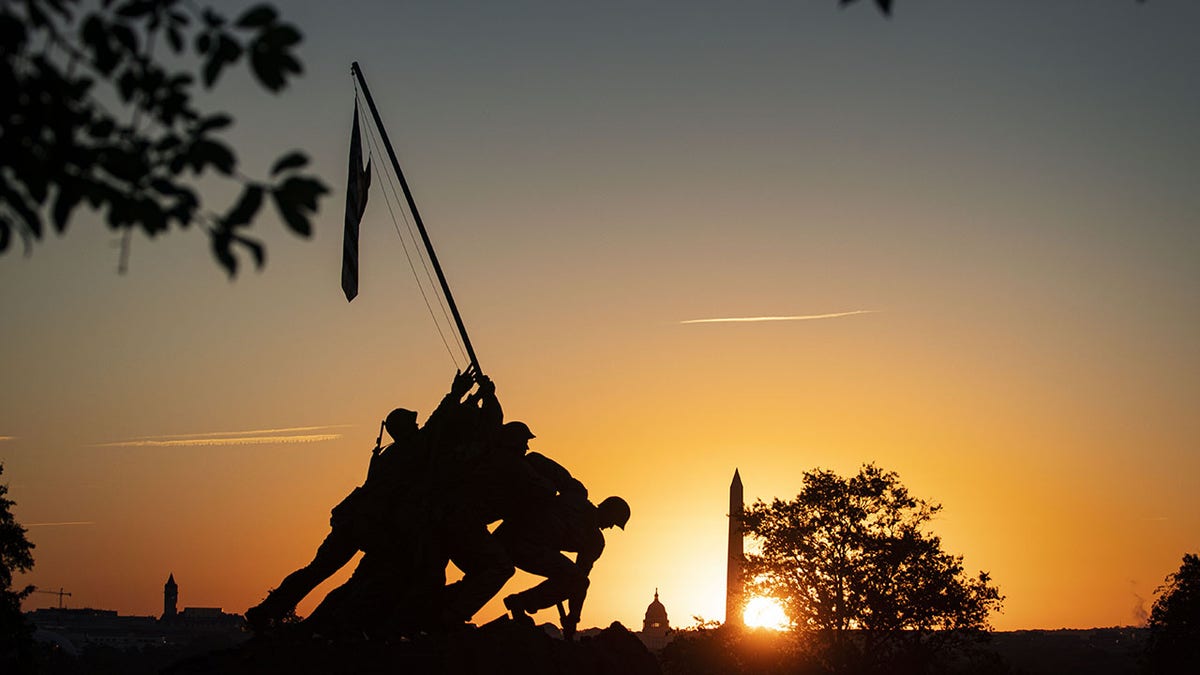
The U.S. Marine Corps Iwo Jima Memorial in front of the U.S. Capitol, center, and the Washington Monument, right, in Arlington, Virginia, Sept. 27, 2021. (Al Drago/Bloomberg via Getty Images)
In recent years it emerged that doctor Bradley was not among the six men in the photo.
He doesn't stop being a hero.
The book written by his grateful son is one of the best ever written about the brutality of war and the cost paid by the men who fought and died in World War II.
CLICK HERE TO GET THE FOX NEWS APP
“Their collective image,” Bradley writes in the Photo Boys' Book, “blurred and indistinct but unforgettable, became the most recognized, the most reproduced, in the history of photography.”
He added: “The raising of the flag on Iwo Jima became a symbol of the island, the mountain, the battle; of World War II; the nation's highest ideals, of embodied courage.”
For more lifestyle articles, visit www.foxnews.com/lifestyle.

